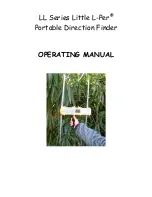
9
take is made, just press “F” to quit and then
“F” and “FREQ” again to start over.
Storing a frequency
After a new frequency is entered, it will
be labeled as “NEW” on the display. There
is no provision for custom labels. This new
frequency will be retained if the power is
turned off and back on but will be lost if any
other memory is loaded. To store this fre-
quency for later use, press “F” then
“STORE”. The letters “ST” will appear on
the left edge of the display. Select a mem-
ory number for storage of this new fre-
quency and press a number from 5 to 0.
The old data, if any, in that memory location
will be erased. The “NEW” label will be re-
placed by the memory number when this
entry is later recalled. An attempt to store to
a permanent memory location (positions 1
through 4) will be rejected.
USING EXTERNAL ANTENNAS
Two BNC jacks are located on the top of
the DF for connecting external antennas.
When set for AUTOmatic operation, any
antenna with a DC resistance of 500 ohms
or less at its connector will be detected by
the DF when it is plugged in. The DF will
shut off its internal antennas and work from
the external one(s). It will return to using its
internal antennas when the external anten-
nas are disconnected. See also section on
Calibration.
The L-Tronics
®
magnetic, flexible, air-
craft, and LH Series L-Per
®
handheld an-
tennas will all be detected. Adding a 470
ohm resistor to the L-Tronics
®
LHBM-1
beam and LVA-1 monitor antennas will al-
low automatic detection of them, plugged
into either jack.
NEVER apply power or more than 10
mW RF or any DC voltage to these jacks.
External antennas can also be selected
manually (see “Other Adjustable Values”
below). The jack that the external antenna is
plugged in to sets whether the DF displays
the data left and right (left/right jack) or up
and down (fore/aft jack). Plugging two an-
tennas at once will switch to the FALR
(Fore/Aft-Left/Right) display.
There are two potential hazards associ-
ated with external antennas:
1. External antennas usually cover only
a narrow frequency range. Beyond
their designed frequency, they can be
wildly erroneous.
2. The DF will not use its internal anten-
nas unless it is set to AUTO (SET1).
Be careful with external antennas to be
sure they are used within their limits. For
example, our magnetic and aircraft anten-
nas have a range of only 118 to 126 MHz
and 235 to 260 MHz.
OTHER ADJUSTABLE VALUES
Several other settings are selectable be-
side frequency, DF mode and volume.
These are controlled through setup screens
“SET1,” ”SET2,” and “SET3.” “SET3” con-
tains only the model number, frequencies,
and revision numbers.
To work with the SET menus, press “F”
and then “SET1,” “SET2” or “SET3.” One or
more items on a menu can be changed in a
single session by selecting its item number.
Except for contrast, these selections are
retained in the individual frequency memo-
ries. To end the session, press “F” again.
SET1 + KEY PAD ENTRY NUMBERS
1.
Pressing this number alternately se-
lects FM or AM audio detection. This selec-
tion affects only what is heard on the
speaker. It does not affect DF operation.
The default is AM below 137 MHz and
above 235 MHz and FM elsewhere.
2.
Pressing this number selects “AUTO,”
“F/A,” “L/R,” and “FALR” antenna switching.
The default for permanent memories is
“AUTO.” The other choices allow for manual
selection when using external antennas that
do not give sensing for automatic selection.
This MUST BE SET to AUTO for the built-in
antennas to work.
3.
Press 3 and then use the up and
down arrows to adjust the display contrast.
If the display is too light to read, hold the UP
arrow and, if it is all black, hold the DOWN
arrow until the display appears. Contrast is
stored in a common memory so the last















